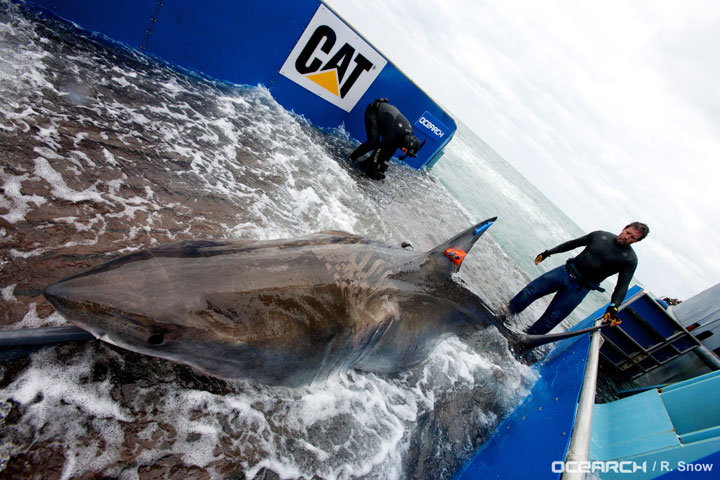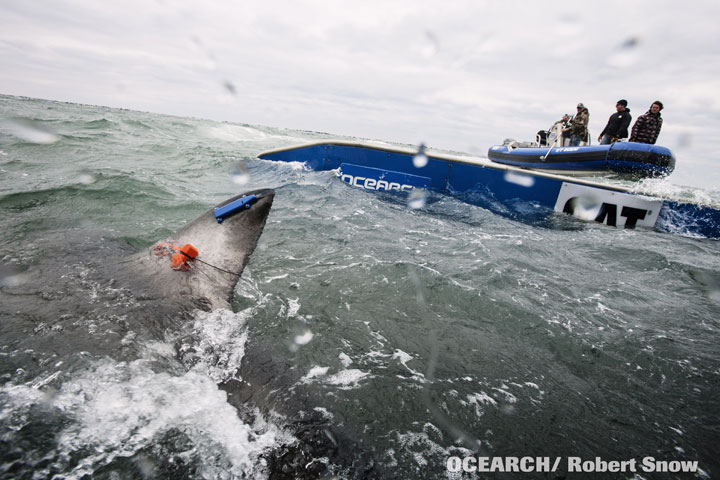TORONTO – When we think of sharks, we think of blank-eyed, Jaws-like creatures with a taste for surfers. But when you look at Lydia, a great white that was tagged by shark researchers, it’s hard not to cheer her on in her travels.

Lydia, a 4-metre, 907-kg great white shark was tagged March 2, 2013, in Jacksonville, Fla. in a program designed to help scientists better understand the movements of great whites in the Atlantic Ocean. And Lydia, who has travelled more than 30,500 km is in the spotlight.
As of March 5, she’s travelled farther north and east than any other known tagged shark.
“Lydia is certainly a shark that has captured our attention,” Greg Skomal told Global News. Skomal is the project leader for the Massachusetts Shark Research Program and tagged Lydia in 2013. He has long had a fascination with sharks, and has turned his passion into a career.
To track Lydia, click here.
His research lead him to collaborate with Ocearch, a non-profit shark research organization. The partnership allowed Skomal to tag sharks using their boat. In addition to the five Skomal’s team tagged using the Ocearch vessel, a further 34 have been tagged.
Chris Fischer, Ocearch’s founding chairman and expedition leader, didn’t get his start in oceans. But he is deeply passionate about Ocearch’s science and hopes that the combined research will affect public policy. His main goal is to make the research real-time and open to everyone. Currently, he said, there are 50 scientific papers being written on the research conducted in collaboration with Ocearch.
Fischer’s interest in oceans stemmed from what he believed was people’s indifference to the ocean.
“I thought, wow, if you live near the water and you’re not connected to the ocean at all, the ocean’s in trouble,” Fischer said. “That’s when I set out to pour the ocean into people’s lives.”
Now, Fischer wants to replace world-renowned oceanographer Jacques Cousteau as the voice of the ocean, but he is a little surprised that he’s become known as “the shark guy.”
And he’s happy that Lydia is helping bring more attention to not only sharks, but the ocean in general.
Lydia’s journey
Lydia has travelled far and wide. Twice, Lydia paid a visit to Canada, tracked off the coast of Newfoundland in Placentia Bay in October 2013, and then off Cape Race, on the province’s southeast coast.
Lydia has taken it to the next level. She’s reached a ridge in the Atlantic Ocean, and so far has been riding along it over several days. Skomal believes that this may indicate that Lydia is diving deep to feed.
“I’m really curious as to whether she’s going to cross into the eastern Atlantic and keep going. I think that would be quite fascinating,” he said.
Sharks do venture into off-shore waters, but how far Lydia travel north and east surprised researchers. Though great whites can get into cold water, she needs to surface every once in a while, likely to get up to warmer water.
Whenever she surfaces, her tracker sends out a “ping,” allowing scientists to track her movements. Researchers will use Lydia’s movements, as well as movements from the other sharks, to paint a bigger picture of shark movement.
- 2021 heat dome fuelled by climate change, intensified wildfire risk: study
- B.C. introduces legislation recognizing Haida Gwaii Indigenous title
- Whale experts confident B.C. orca calf will survive, find family if rescue plan succeeds
- Chemical plant shuts down after high benzene levels detected near Ontario First Nation
“She’s taught us that these sharks spend quite a lot of time in international waters, and that in and of itself is important when it comes to protection of the species,” Skomal said. He also said that it might give them a better idea about genetic exchange between sharks in the east and the west.
The perception of sharks as mindless killers is one that largely came out of the 1978 Stephen Spielberg movie Jaws.
“The media is the primary vector for shark exploitation in terms of propogating the myth that sharks consume human beings,” he said. “There are staistics that indicate that sharks do bite people, but the probabilities are quite low.”
Skomal believes that our perception is changing, however.
“I think we’re becoming more educated as a population,” he said. “And with education comes the perception that sharks are just a natural component of the ecosystem and that when we, as terrestrial animals go into that ecosystem, take an inherent risk.”
It’s obvious that Skomal has a love of sharks. When asked if he has a favourite shark, he said, “It’s hard to because it changes. Right now, obviously Lydia’s getting a lot of attention in the fact that she’s breaking really new ground for us. Sure she’s at the top of my list of people…” Skomal chuckled. “I mean, sharks, to watch right now.”
Asked what’s next for Lydia, Skomal again laughed.
“I have no idea. One thing I’ve learned with watching Lydia is, I can’t tell what she’s going to do next.”






Comments